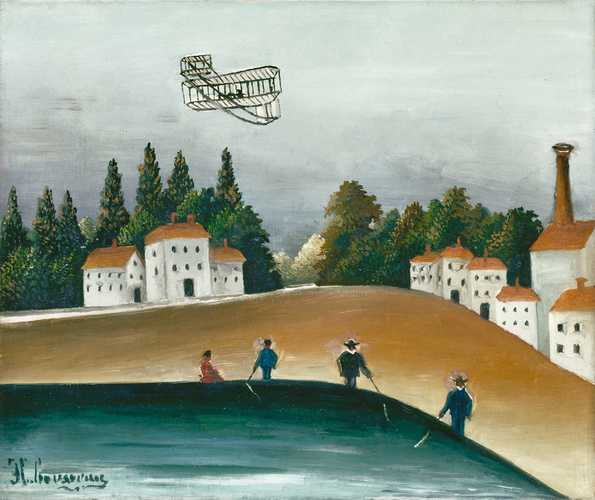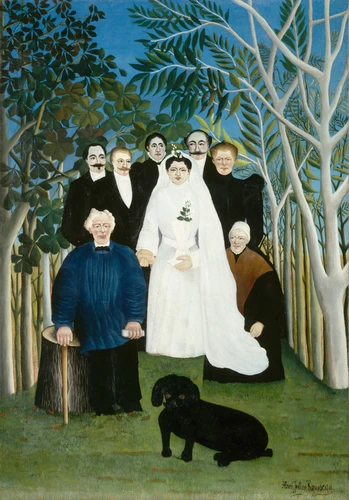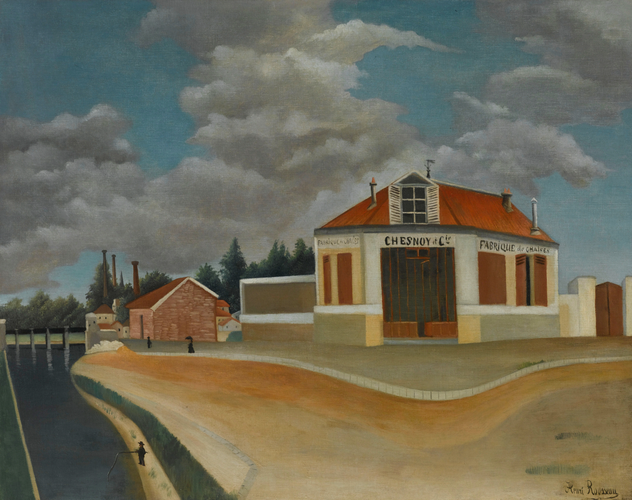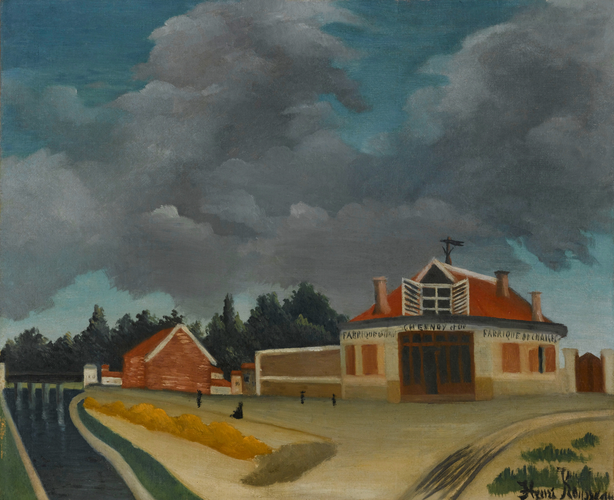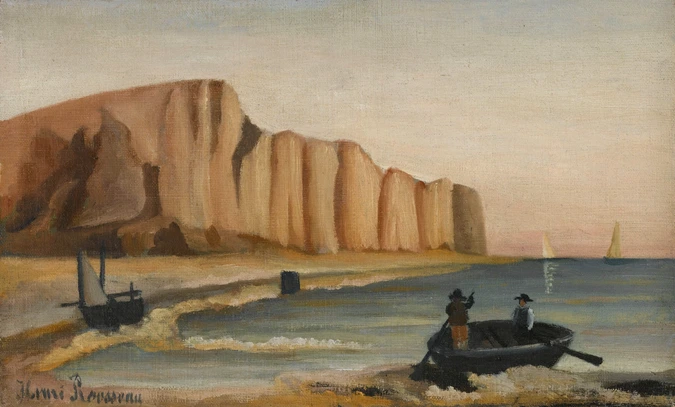La Carriole du Père Junier

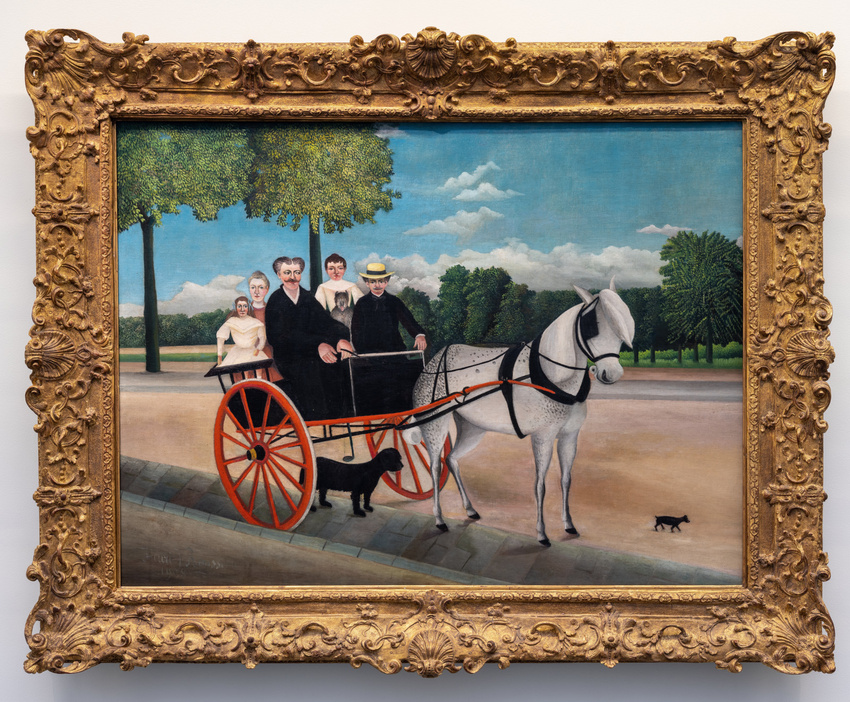
"Père Junier" used to sell vegetables that he would go to buy every morning from the market gardeners in Bagneux or Verrière-le-Buisson. He had been a friend of Rousseau’s for many years; his wife used to cook for him. As the painter owed him some money and M. Junier had just bought a horse of which he was very proud, it was agreed that Rousseau would do a painting of it.
Rousseau worked from a photograph. However he made several important changes that reveal his creative process. He omitted a tree on the boulevard and played particularly on the size and position of the three dogs. These have a visual function. The fat black dog gives depth to the cart. We know that when Max Weber commented to Rousseau that the black dog was too big in relation to the overall scale of the painting, the artist retorted that his painting demanded this. The miniature dog, on the other hand, trotting in front of the cart gives a monumentality to the mare. She stands rather curiously on the tips of her hooves, thus highlighting the shadows cast on the ground. This mare, like a dancer on her points, seems almost suspended in space. Rousseau was very fond of this type of paradox, which makes some characters float in a purely pictorial space.
The passengers in the cart, with the exception of Monsieur Junier, are shown in strict frontality like Byzantine icons.
Provenance: M. Junier; P. Rosenberg, Paris; A. Vollard, Paris (1918); Paul Guillaume (1927); Domenica Walter
- collection Claude Junier, Paris
- collection Paul Rosenberg, Paris
- à partir de 1918, dans la collection Antoine Villard, Paris
- à partir de 1927, dans la collection Paul Guillaume, Paris
- jusqu'en 1959, dans la collection de Mme Jean Walter, Paris
- 1959, acquis de Mme Jean Walter avec le concours de la Société des Amis du Louvre (arrêté d'approbation de la vente du 21/02/1959)
- musée du Louvre, Paris
- 1977, musée de l'Orangerie, Paris, entrée matérielle
- Salon de la Société des artistes indépendants - quai d'Orsay, Pont de l'Alma - France, Paris, 1911
- Trente ans d'art indépendant, 1884-1914 - Galeries nationales du Grand Palais - 1926
- Paintings by Henri Rousseau "Le Douanier" - Alex Reid and Lefevre Gallery - Royaume-Uni, Londres, 1926
- Collection particulière de M. Paul Guillaume - galerie Bernheim-Jeune - France, Paris, 1929-1905
- Exhibition Henri Rousseau - - 1931
- Henri Rousseau - Kunsthalle Basel - 1933
- Hommage du musée de Grenoble à Paul Guillaume - Petit Palais - Musée des Beaux-Arts de la Ville de Paris - France, Paris, 1935
- Ten important Paintings by XX Century French Masters - The Valentine Gallery - Etats-Unis, New York, 1936-1949
- Exposition Henri Rousseau (1844-1910) - galerie Paul Rosenberg - France, Paris, 1937
- Les Maîtres de l'art indépendant 1895-1937 - Petit Palais - Musée des Beaux-Arts de la Ville de Paris - France, Paris, 1937
- Henri Rousseau : Le Douanier - musée d'Art moderne de la Ville de Paris - France, Paris, 1944-1945
- Henri Rousseau - - Etats-Unis, New York, 1951
- Collection Jean Walter-Paul Guillaume - musée de l'Orangerie - France, Paris, 1966
- Visages et portraits de Manet à Matisse - palais de Tokyo - musée d'Art et d'Essai - France, Paris, 1981
- Le Douanier Rousseau - Galeries nationales du Grand Palais - 1984-1985
- Le Douanier Rousseau - Museum of Modern Art - 1985
- Paris 1937 : l'art Indépendant (exposition présentée dans le cadre du cinquantenaire de l'Exposition Internationale des arts et des techniques dans la vie moderne) - musée d'Art moderne de la Ville de Paris - France, Paris, 1987
- Apollinaire critique d'art - Pavillon des Arts - 1993
- Chefs-d'oeuvres du musée de l'Orangerie : collection Jean Walter et Paul Guillaume - Bunkamura Museum of Art - Japon, Tokyo, 1998-1999
- Chefs-d'oeuvres du musée de l'Orangerie : collection Jean Walter et Paul Guillaume - City Art Museum - Japon, Nagoya, 1999
- Chefs-d'oeuvres du musée de l'Orangerie : collection Jean Walter et Paul Guillaume - Prefectural Art Museum - Japon, Hiroshima, 1999
- Chefs-d'oeuvres du musée de l'Orangerie : collection Jean Walter et Paul Guillaume - Niigata City Art Museum - Japon, Niigata, 1999
- Chefs-d'oeuvres du musée de l'Orangerie : collection Jean Walter et Paul Guillaume - National Museum of Modern Art - Japon, Kyoto, 1999
- Chefs-d'oeuvre du musée de l'Orangerie : collection Jean Walter et Paul Guillaume - Taïpei Fine Arts Museum - Taïwan, Province de Chine, Taïpei, 1999-2000
- Chefs-d'oeuvre du musée de l'Orangerie : collection Jean Walter et Paul Guillaume - Kaohsiung Museum of Fine Arts - Taïwan, Province de Chine, Kaohsiung, 2000
- De Renoir à Picasso : chefs-d'oeuvre du musée de l'Orangerie - musée des beaux-arts - Canada, Montréal, 2000
- De Renoir à Picasso : chefs-d'oeuvre du musée de l'Orangerie - Kimbell Art Museum - Etats-Unis, Fort Worth, 2000-2001
- Renoir to Picasso : Masterpieces from the Musée de l'Orangerie - Queensland Art Gallery - Australie, Brisbane, 2001
- Renoir to Picasso : Masterpieces from the Musée de l'Orangerie - Art Gallery of New South Wales - Australie, Sydney, 2001
- Renoir to Picasso : Masterpieces from the Musée de l'Orangerie - National Gallery of Victoria - Australie, Melbourne, 2001
- De Renoir a Picasso : Obres mestres del Musée de l'Orangerie, Paris - CaixaForum - Espagne, Barcelone, 2002
- Obras Maestras del Musée de l’Orangerie - Museo Dolores Olmedo - Mexique, Mexico, 2013-2014
- Henri Rousseau. Archaic Naiveté - Palazzo Ducale - Italie, Venise, 2015
- Le Douanier Rousseau. L'innocence archaïque. - musée d'Orsay - France, Paris, 2016
-
Anonyme, Album, [s.n.], *vu [crayon] *[é]galement en petit format [...]15 (réserve) "La Carriole du Père Juniet" 1908 97 x 129 [crayon] Reproduit Arts à Paris n°13, juin 1927 - Reprod
-
Walter, Domenica, Classeur Domenica Walter, [s.n.], Fol. 47 recto 815 La carriole 129 x 97 LOU avec point bleu souligné en bleu et vert Photo collée Lo
-
Walter, Domenica, Classeur, [s.n.], Fol. 47 recto 815 La carriole 129 x 97 LOU avec point bleu souligné en bleu et vert Photo collée 9
-
Les Soirées de Paris, n° 20, [s.n.], 1914, n° 20, repr. p. 63 ["La Carriole de M. Juniet", "Collection P. Rosenberg"]
-
Uhde, Wilhelm, Henri Rousseau, Düsseldorf, Verlag von Ernst Ohle, 1914, repr. pl. [14] ["Die Spazierfahrt", "Bes. Kunstsalon Rosenberg, Paris"]
-
Bouret, Jean, Les Lettres françaises 16-22, "Rousseau dit “le douanier”", Les Lettres françaises , [s.n.], 1919, p. [12], repr.
-
Grey, Roch, Rousseau avec 32 reproductions en phototypie, Editions de "Valori Plastici", 1922, s.n., repr. n.p. ["La carriole de Mr. Juniet", "Collection : A. Villard"]
-
Kolle, Helmud, Henri Rousseau, Leipzig, Klinkhardt & Biermann, 1922, repr. pl. 17 ["Spazierfahrt", "Sig. A Villard"]
-
The Art News , XXLV, n° 5, [s.n.], 1925, s.n., mentionné p. 1, repr. ["La carriole du Père Juniet", "A. Villard"]
-
The Art news, Vol XXV, n° 4, Twelve Rousseaus shown in London, [s.n.], 1926, s.n., mentionné p. 1 ["La carriole du père Juniet"]
-
L' Art vivant, t.2, Informations, [s.n.], 1926, mentionné p. 199 ["La carriole du père Juniet"]
-
Basler, Adolphe, L' Art vivant, Le "Douanier" Henri Rousseau, [s.n.], 1926, p. 778 ["La Carriole de M. Juniet"]
-
George, Waldemar, L' Amour de l'art, Trente ans d'Art indépendant, [s.n.], 1926, p. 94, repr. p. 93 ["La charrette", "Coll. Villard"]
-
Lehel, Francois, Notre art dément : quatre études sur l'art pathologique, Paris, H. Jonquières et Cie, 1926, repr. pl. 25 ["Galerie Paul Guillaume"]
-
Les Arts à Paris : actualités critiques et littéraires des arts et de la curiosité, [s.n.], 1927, n° 13, juin 1927, repr. p. 7 ["La Carriole du Père Juniet", "Collection particulière Paul Guillaume"]
-
Basler, Adolphe, Henri Rousseau : (sa vie - son oeuvre), Paris, Librairie de France, 1927, repr. pl. 13 ["La charette de M. Juniet"]
-
Salmon, André, Henri Rousseau dit le Douanier, Paris, Crès, 1927, n° 34, p. 140, repr. ["La Carriole de M. Juniet", "Photo. Galerie Paul Guillaume"]
-
Soupault, Philippe, Henri Rousseau, le Douanier, Paris, Editions des Quatre Chemins, 1927, p. 31, repr. pl. 32 ["La Carriole de M. Juniet"]
-
Zervos, Christian, Rousseau, Paris, Cahiers d'Art, 1927, repr. pl. 3 ["La carriole de M. Juniet", "Ces tableaux appartiennent à M. Paul Guillaume"]
-
Basler, Adolphe, L' Amour de l'art, M. Paul Guillaume et sa collection de tableaux, [s.n.], 1929, p. 256 ["Charette de M. Juniet", "M. Paul Guillaume"]
-
Basler, Adolphe, Henri Rousseau, Paris, Gallimard, 1929, repr. p. 37 ["La Charrette de M. Juniet", "Collection Paul Guillaume"]
-
George, Waldemar, La Renaissance, La grande peinture contemporaine à la collection Paul Guillaume, [s.n.], 1929, p. 174-175 ["Carriole du Père Juniet", "collection Paul Guillaume"]
-
George, Waldemar, La Grande Peinture contemporaine à la collection Paul Guillaume, Paris, Ed. des Arts à Paris, 1929, p. 55, repr. p. 59 ["La carriole du père Juniet", "collection Paul Guillaume"]
-
Combe, Jacques, L' Amour de l’art , n° 12, "Un douanier Rousseau au XVIIe siècle : Franz Post (1612-1680)", [s.n.], 1931, mentionné p. 485, repr. p. 487, fig.38 ["La charrette de M.Juniet"]
-
Warnod, André, Conferencia, Chez le collectionneur Paul Guillaume, [s.n.], 1931, p. 408, repr. p. 403 ["La Carriole du Père Juniet", "Paul Guillaume"]
-
Uhde, Wilhelm, L' Amour de l'art, Henri Rousseau et les primitifs modernes, [s.n.], 1933, repr. fig. 237, p. 189 ["La Carriole du père Juniet"]
-
"Hommage du musée de Grenoble à Paul Guillaume " [Section autonome de l' exposition Les Chefs-d'Oeuvre du musée de Grenoble, 1935, Paris, Petit Palais], [s.n.], 1935, n° 412, cat. n.p. [
-
Bertram, Anthony, Henri Rousseau, le Douanier 1844-1910, New York, The Studio, 1936, n° 12, repr. pl. 12 ["The Tilt-cart of père Juniet", "Messrs. Alex Reid and Lefevre"]
-
Morsell, Mary, The Art News, French Masters of XXth Century in Valentine Show, [s.n.], 1936, p. 3, repr. p. 1 ["La carriole du père Juniet"]
-
Escholier, Raymond, La Peinture française, XXe siècle, Paris, Floury, 1937, repr. p. 107 ["La carriole", "Vizzavona"]
-
Zervos, Christian, Histoire de l'art contemporain, Paris, Cahiers d'Art, 1938, repr. p. 107 ["La Carriole de M. Juniet", "Appartient à Madame Paul Guillaume"]
-
Huyghe, René, Les Contemporains, Paris, Pierre Tisné, 1939, n° 94, repr. pl. 94 ["La carriole du père Juniet", "Photo : Giraudon"]
-
Salmon, André, Les Beaux-Arts , n° 64, "Le Tombeau du Douanier", [s.n.], 1942, repr. p. 3 ["La carriole du père Juniet", "Toile appartenant au Musée de Grenoble"]
-
Grey, Roch, Henri Rousseau, Paris, Ed. TEL, 1943, repr. pl. 6 ["La carriole de Monsieur Juniet", "Collection Paul Guillaume"]
-
Buzzichini, Mario, Henri Rousseau, Milan, Hoepli, 1944, repr. pl. I ["Biroccino del Signor Juniet", "Parigi : Collezione Vedova Paul Guillaume"]
-
Courthion, Pierre, Henri Rousseau le Douanier, Genève, Skira, 1944, repr. pl. III ["La Carriole du père Juniet", "Coll. Paul Guillaume"]
-
Catton Rich, Daniel, Henri Rousseau, New York, [s.n.], 1946, mentionné p. 52, repr. 53 ["The cart of Père Juniet", "Collection de Mme Paul Guillaume"]
-
Rich, Daniel Catton, Henri Rousseau, New York, The Museum of Modern Art, 1946, p. 52, repr. p. 53 ["The Cart of Père Juniet", "Collection Madame Paul Guillaume, Paris"]
-
Uhde, Wilhelm, Rousseau (le Douanier), A. Scherz, 1948, n° 41, n.p. et mentionné p. 31, repr. n.p. ["Der Wagen des Père Juniet", "Paris, Sammlung P. Guillaume Photo Spreng, Basel"]
-
Gauthier, Maximilien, Henri Rousseau, Paris, Les Gémeaux, 1949, repr. pl. XXI ["La carriole de M.Juniet"]
-
Uhde, Wilhelm, Cinq maîtres primitifs. Rousseau - Vivin - Bombois - Bauchant - Seraphine, Paris, Philippe Daudy, 1949, s.n., repr. [p. 38] ["La Carriole du Père Juniet"]
-
Cooper, Douglas, Rousseau, Paris, Les Editions Braun et Cie, 1951, repr. coul. p. [45] ["La carriole du père Juniet", "Collection particulière"]
-
Duca, Lo, Henri Rousseau, dit le Douanier, Paris, Editions du Chêne, 1951, repr. fig. p. 11 ["La Carriole du père Juniet"]
-
Delaunay, Robert, Les Lettres francaises, Mon ami Henri Rousseau, [s.n.], 1952, p. 1, repr. ["La carriole de M. Juniet"]
-
Delaunay, Sonia, Les Lettres françaises, Images inédites du douanier Rousseau, [s.n.], 1952, p. 8 ["Carriole au cheval blanc", "été 1911: acheté par Apollinaire "Lété de 1911 [...] à Meudon [...] nous découvrimes chez un épicier, deux tableau magnifique
-
Courthion, Pierre, Henri Rousseau, Paris, Fernand Hazan, 1956, n° 14, repr. coul. p. 14 ["La carriole du Père Juniet", "Collection particulière, Paris"]
-
Perruchot, Henri, Le Douanier Rousseau, Paris, Editions Universitaires, 1957, repr. pl. XI ["La carriole de M. Juniet", "Photo : Vizzavona"]
-
Werner, Alfred, Henri Rousseau (1844-1910), New York, Harry N. Abrams, 1957, n° 4, repr. ["Cart of père Juniet", "Collection Mme Jean Walter, Paris"]
-
Gatard, Marie, Paris Match , n° 513, "Par son premier mari, Paul Guillaume, Domenica est aussi toute la peinture moderne", [s.n.], 1959, repr. ["La carriole du père Juniet", "Domecica Walter"]
-
Bouret, Jean, Henri Rousseau, Neuchâtel, Ides et Calendes, 1961, n° 42, p. 252, repr. coul. p. 143 ["La carriole du père Juniet", "Paris, Mme Jean Walter"]
-
Certigny, Henry, La vérité sur le douanier Rousseau, Paris, Plon, 1961, mentionné p. 320-321, repr. pl. [entre p.326-327]
-
Labrosse, A., Montmartre , n°1, Des révélations sur le douanier Henri Rousseau, [s.n.], 1961, n.p., repr. photographie n.p.
-
Vallier, Dora, Henri Rousseau, Paris, Flammarion, 1961, n° 136, p. 82 et mentionné p. 309, repr. fig. 136 (La carriole du Père Juniet)
-
Salmon, André, Henri Rousseau, Paris, Aimery Somogy, 1962, repr. coul. p. 64 (La carriole du père Juniet)
-
Tzara, Tristan, Art de France , n°2, "Le rôle du temps et de l’espace dans l’oeuvre du Douanier Rousseau", [s.n.], 1962, p. 326
-
Courthion, Pierre, Dictionnaire de la peinture moderne, Paris, [s.n.], 1963, p. 320-321, repr. coul. p. 320
-
Cheronnet, Louis, Médecines, peintures, "Rousseau" in, [s.n.], 1964, n.p., repr. pl. X
-
Collection Jean Walter-Paul Guillaume, Paris, Réunion des musées nationaux, 1966, n° 51, repr. n. p.
-
Bouret, Jean, Les Lettres françaises, Prélude à l’Orangerie, [s.n.], 1966, p. 16, repr. (La charrette du père Juniet)
-
Lemoyne de Forges, Marie-Thérèse ; Allemand, Geneviève ; Bundorf, Michèle, Collection Jean Walter-Paul-Guillaume : catalogue, Paris, Réunion des musées nationaux, 1966, p. 57, repr. fig. 6, p. 60
-
Rheims, Maurice, Elle, Les secrets de la fabuleuse collection qu’elle donne au Louvre, [s.n.], 1966, mentionné p. 62, repr.
-
Schurr, Gérald, La Galerie des Arts, n°36, La collection Paul Guillaume-Jean Walter. Un investissement unique, [s.n.], 1966, s.n., repr. coul. p. 54-55 ["
-
Zadkine, Osip, Le Maillet et le ciseau, Paris, Albin Michel, 1968, p.78
-
Léonard, Sandra F., Henri Rousseau and Max Weber, New York, Richard L. Feigen, 1970, p. 29
-
Vallier, Dora, Revue de l’art, n° 7, L' emploi du pantographe dans l’oeuvre du douanier Rousseau, [s.n.], 1970, s.n., p. 97, repr. fig. 21 ["Carriole du père Junier", "Paris, Musées nationaux, coll. J. Walter-P. Guillaume"]
-
Bihalji-Merin, Oto ; Bihalji-Merin, Lise, Leben und Werk des Malers Henri Rousseau , Dresde, Veb, 1971, Dresde, Veb, 1971, p. 21, 25, 66 et mentionné p. 247, repr. p. de couv. en coul., frontispice, pl. 34 en coul. et pl. 36 (
-
Descargues, Pierre, Henri Rousseau, Genève, Skira, 1972, repr. coul. pl. p. 97
-
Nezval, V., Nezval. Insita 4, Bratislava, [s.n.], 1972, p. 112
-
Daval, Jean-Luc, Journal de l’art moderne : 1884-1914, Genève, Skira, 1973, p. 303, repr. p. 224 ["La carriole de M. Juniet", "Paris, Musées Nationaux, collection de Mme Paul Guillaume"]
-
Nacenta, Raymond, Les Naïfs, Paris, Nouvelles éditions françaises, 1973, n° 3, repr. coul. pl. 3
-
Larkin, David, Rousseau, Paris, Ed. du Chêne, 1975, n° 25, repr. coul.
-
Maillard, Robert ; Huyghe, René, Dictionnaire universel de la peinture , 6 tomes, Dictionnaires Robert, 1975, t. 6, mentionné p. 20, repr. coul. p. 21
-
Niggli, Ida, Naive Kunst, : Gestern und heute= Naive Art : Yersterday and Today, Niederteufen, Arthur Niggli, 1976, n° 78, repr. p. 48
-
Lonzi, C., Le Douanier Rousseau , Coll. Chefs d’oeuvres de l’art grands peintres [Trad. de l’italien 1ère éd. 1966], Paris, Hachette, 1979, p. [1], repr. coul. pl. IX
-
Muller, Joseph-emile ; Elgar, Frank, Cent ans de peinture moderne, Paris, Hazan, 1979, p. 170, repr. coul.
-
Vallier, Dora, Henri Rousseau, le Douanier : un dossier, Paris, Flammarion, 1979, mentionné p. 93, repr. coul. pl. p. 81
-
Elgar, Frank, Rousseau [Coll. les Maitres de l’art], Paris, Fernand Hazan, 1980, repr. coul. pl. 50
-
"Musée d’art et d’essai : 6 présentations temporaires d’oeuvres du musée du Louvre et des collections nationales n° 8", [s.n.], 1981, n° 9, repr. n.b. p. 35, repr. coul. p. 57
-
Higashino, Tono, . 25 Great Masters of Modern Art : Rousseau ,, Tokyo, Kodansha, 1981, n° 49, p. 123 et mentionné p. 132, repr. coul. pl. et repr. p. 123
-
Le Pichon, Yann, Le Monde du Douanier Rousseau, Paris, Robert Laffont, 1981, p. 57, 58 et mentionné p. 282, repr. coul. pl.
-
Vallier, Dora, Tout l'oeuvre peint de Henri Rousseau, Paris, Flammarion, 1982, n° 212, p. 109, repr., repr. coul. pl. 48-49 (XLVIII-IL) ["La Carriole du père Jugniet", "Coll. : Paul Rosenberg, Paris (1914). A. Villard, Paris (1922). Paul G
-
Le Douanier Rousseau, Paris, Réunion des musées nationaux, 1983, n° 39, p. [2], repr. p. [2] n° 39, p. [2], repr. p. [2] n° 39, p. [2], repr. p. [2] n° 39, p. [2], repr. p. [2] n° 39, p. [2], repr. p. [2] n° 39, p. [2],
-
Beauvais, Patricia de, Paris- Match, Les gloires de l’Ecole de Paris, [s.n.], 1984, mentionné p. [133], repr. coul. [132-133]
-
Certigny, Henry, Le Douanier Rousseau en son temps : biographie et catalogue raisonné, Tokyo, Bunkazai Kenkyujyuo Co, 1984, n° 270, t. II, p. 568-570, repr. p. 569 ["La Carriole du Père Juniet", "Claude Juniet, 1908. P. Rosenberg, Paris, 1914. Vendu par Rosenberg à Antoine Villard en
-
Hoog, Michel ; Certigny, Henry ; Abadie, Daniel ; , Le Douanier Rousseau, [s.n.], 1984, p. 45, repr. coul. p. 44
-
Le Targat, François, Beaux-Arts magazine, n° 17, "Douanier Rousseau : le plus grand des modernes", [s.n.], 1984, p. 32, repr. coul. p. 33
-
Marceau, Felicien, La Carriole du père Juniet d’après le tableau de Henri Rousseau, Paris, Editions de La Différence, 1985, repr. coul. p. de couv.
-
Sakai, Tadayasu, Rousseau, Tokyo, Shueisha, 1985, n° 18, repr. coul.
-
Contensou, Bernadette, L' Oeil , n° 382, "Le Centenaire de l’Exposition Internationale de 1937", [s.n.], 1987, n° 9, p. 55, repr. p. 35 et repr. coul. p. 57
-
Hoog, Michel ; Guicharnaud, Hélène ; Giraudon, Colette, Musée de l’Orangerie : catalogue de la collection Jean Walter et Paul Guillaume, 3ème éd. revue et mise à jour [1ère éd. 1984], Paris, Réunion des musées nationaux, 1990, n° 110, p. 244, 246, repr. coul. p. 245, détail p. 247 (La Carriole du Père Junier)
-
Giraudon, Colette, Paul Guillaume et les peintres du XXe siècle : de l’art nègre à l’avant-garde, Paris, La Bibliothèque des arts, 1993, mentionné p. 114, 116, repr. coul.
-
Robert, Paul ; Rey, Alain, Le Petit Robert 2 : dictionnaire universel des noms propres ,, Paris, Le Robert, 1993, mentionné p. 1565
-
Lemaire, Gérard-Georges, Le Douanier Rousseau 1844-1910, Paris, Cercle d'art, 1997, n° 28, n.p. et mentionné p. 62, repr. coul. n.p. et 4ème de couv.
-
Le petit Léonard , n° 17, Juillet-août 1998, Une oeuvre expliquée : La Carriole du Père Junier, [s.n.], 1998, p. 28-29, repr.
-
Georgel, Pierre ; Peng, Chang-Ming, Chefs-d'oeuvre du musée de l'Orangerie : collection Jean Walter et Paul Guillaume., Taïpei, China Times, 1999, n° 39, p. 122, repr. coul. 123
-
Green, Christopher ; Morris, Frances ; Frèches-Thory, Claire, Le Douanier Rousseau : jungles à Paris, Paris, Réunion des musées nationaux, 2006, mentionné p. 182, 230 (La Carriole du père Juniet) mentionné p. 182, 230 (La Carriole du père Juniet) mentionné p. 182, 230 (La Carriole du père Juniet)
-
Von der Weid, Jean-Noël, Musée de l’Orangerie : guide de visite, Artlys, 2006, mentionné p. 49, repr. coul
-
Joannidès, Dimitri, La Gazette de l’Hôtel Drouot , n° 7, 19 février 2010, p. 140-141, Henri, dit le Douanier Rousseau, [s.n.], 2010, repr. coul. p. 140
-
Henri Rousseau (7 février -9 mai 2010) : notices de salles, Fondation Beyeler, 2012, n° 6, p. 9
-
salon des indépendants, 27ème exposition, cat. exp. (Paris, Salon des Indépendants, du 2 avril au 13 juin 1911), Paris, [s.n.], 1911, n° 46 (cat. p. 365 ["La charette", "M. Juniet"])
-
Trente d'art indépendant (1884-1914), cat. exp. (Paris, Grand Palais, 1926), Paris, [s.n.], 1926, n° 3184 (cat. p. 201 ["La carriole de M. Juniet", "Appartient à M. A. Villard"])
-
French School of the Last 100 Years, cat. exp. (Londres, Reid & Lefèvre, 1926), [s.n.], 1926, n° 1 (cat. n.p.)
-
Collection particulière de M. Paul Guillaume, cat. exp. (Paris, Bernheim-Jeune, 1929), [s.n.], 1929, s.n. (sans cat.)
-
Exhibition Henri Rousseau, cat. exp. (New York, Marie Harriman, 1931), [s.n.], 1931, n° 12 (cat. n.p. ["The Cart of M. Juniet", "Collection of Mr. Paul Guillaume, Paris"])
-
Henri Rousseau, cat. exp. (Bâle, Kunsthalle, 1933), Bâle, [s.n.], 1933, n° 51 (cat. p. 15, repr. ["La carriole du Père Juniet", "Bes. Paul Guillaume, Paris"])
-
Ten important Paintings by XX Century French Masters, cat. exp. (New York, Valentine, 1936)), [s.n.], 1936, n° 3 (cat. n.p. ["La charette de M. Juniet"])
-
Les Maîtres de l'art indépendant, cat. exp. (Paris, Petit Palais, 1937), [s.n.], 1937, n° 2 (cat. p. 18, repr. ["La Carriole du père Juniet", "A Mme Paul Guillaume"])
-
Exposition Henri Rousseau (1844-1910), cat. exp. (Paris, Paul Rosenberg, 1937), [s.n.], 1937, n° 11 (cat. n.p., repr. ["La carriole du père Juniet", "Collection Paul Guillaume"])
-
Henri Rousseau, cat. exp. (New York, MoMA, 1942), [s.n.], 1942, s.n. (cat. p. 53, repr. ["The Cart of Père Juniet", "Collection Madame Paul Guillaume, Paris", "Not in the exhibition"])
-
Henri Rousseau : Le Douanier, cat. exp. (Paris, MAMVP, 1944-45), [s.n.], 1944, n° 4, cat. p. 28, repr. p. 17
-
XXVe Biennale de Venise, cat. exp. (Venise, Palais central, 1950), [s.n.], 1950, n° 16, cat. p. 242
-
Henri Rousseau, cat. exp. (New York, Sidney Janis, 1951), [s.n.], 1951, n° 18, cat. n.p., repr.
-
Bouret, Jean ; Nacenta, Raymond ; Gauthier, Maximilien, Henri Rousseau dit “Le Douanier”, cat. exp. (Paris, galerie Charpentier, 1961), Paris, Galerie Charpentier, 1961, n° 76, n.p., repr. n.p. (La Carriole de Monsieur Juniet)
-
Visages et portraits de Manet à Matisse, cat. exp. (Paris, Palais de Tokyo, 1981-1982), Paris, [s.n.], 1981, s.n., repr. p. 10
-
Hoog, Michel ; Lanchner, Carolyn ; Rubin, William ; Shattuck, Roger ; Behar, Henri, Le Douanier Rousseau, cat. exp. (Paris, Galeries nationales du Grand Palais, du 14/09/1984 au 07/01/1985 ; New York, Museum of modern art, 05/02/1985 au 04/06/1985), Paris, Réunion des musées nationaux, 1984, ° 39, p. 197, 198, repr. coul. p. 199; n° 39, p. 59, 64, repr. p. 64
-
Contensou, Bernadette ; Goldscheider, Cécile ; Hoog, Michel, Paris 1937 : l’art indépendant, cat. exp. (Paris, MAMVP, 1987), Paris, Musée d'art moderne, 1987, n° 20, p. 60, repr. coul. 61
-
Riottot El-Habbib, Béatrice ; Gille, Vincent ; Décaudin, Michel, Appolinaire: critique d’art, cat. exp. (Paris, Pavillon des Arts, 1993), Paris, Gallimard, 1993, n° 108 (cat. p. 252, repr. coul. 84,85)
-
Georgel, Pierre ; Kijima, Shunsuke ; Nagai, Takanori, Chefs-d'oeuvre du musée de l'Orangerie : collection Jean Walter et Paul Guillaume, cat. exp. (Tokyo ; Nagoya ; Hiroshima ; Niigata ; Kyoto, 1998-1999), Tokyo, NTV, 1998, n° 39, p. 102, 206, 207, repr. coul. p. [103]
-
Kleeblatt, Norman L. ; Silver, Kenneth E., An Expressionist in Paris : the Paintings of Chaim Soutine, cat. exp. (New York ; Los Angeles ; Cincinnati, 1998-1999), New York, Prestel, 1998, p. 27
-
Georgel, Pierre ; Labiau, Jean-Pierre, De Renoir à Picasso : chefs d'oeuvre du musée de l'Orangerie, cat. exp. (Montréal ; Fort Worth, 2000-2001), Montréal, Musée des Beaux-Arts, 2000, n° 37, p. 168, repr. coul. p. 156, 169; mentionné p. 71-72
-
Büttner, Philippe ; Green, Christopher ; Hohler, Franz, Henri Rousseau, cat. exp. (Bâle, fondation Beyeler, 7 février-9 mai 2010), Ostfildern, Hatje Cantz, 2010, n° 31, p. 16, 23, 25, 27, 36 et mentionné p. 118 et p. 6 du supplément en français, repr. coul. p. 25, 54-55
-
(dir.) Belli, Gabriella ; Cogeval, Guy, Le Douanier Rousseau. L'innocence archaïque, cat. exp. (Paris, musée d'Orsay, 22 mars-17 juillet 2016), Paris, Hazan, 2016, n° 16, pl. coul. p. 125
-
Chefs-d'oeuvre du Musée de l'Orangerie, collection Jean Walter et Paul Guillaume, cat. exp. (Yokohama Museum of Art, 21 septembre 2019-13 janvier 2020), Yokohama, Yokohama, Yokohama Museum of Art, 2019, n° 20, p. 70, pl. coul. p. 70-71
-
Focillon, Henri, La peinture aux XIXe et XXe siècles : du Réalisme à nos jours, Paris, H. Laurens, 1928, s.n., mentionné p. 303 ["La carriole de M. Jeuniet"]
Do you have a question where you have additional knowledge about this work? You can write to us to suggest improvements to the file.
Make a suggestion